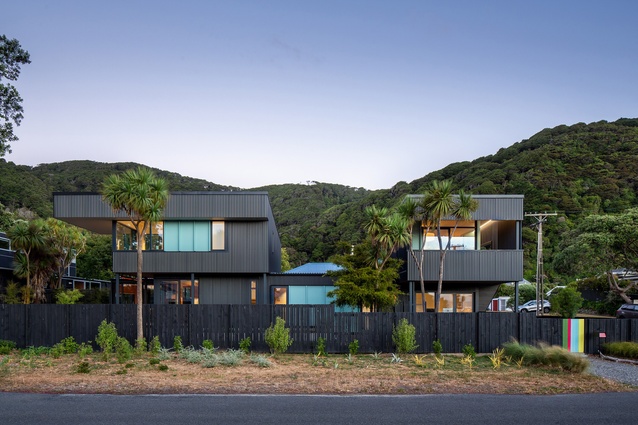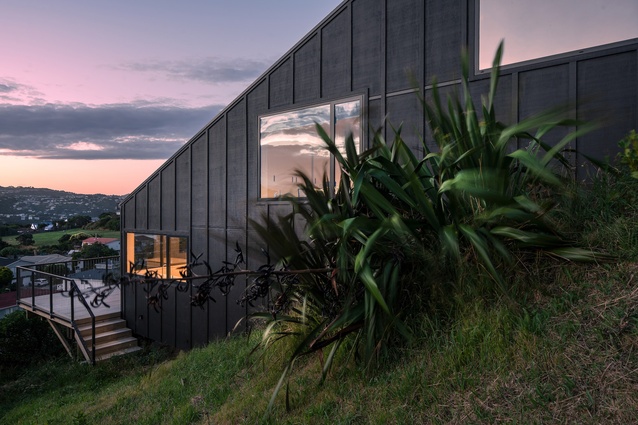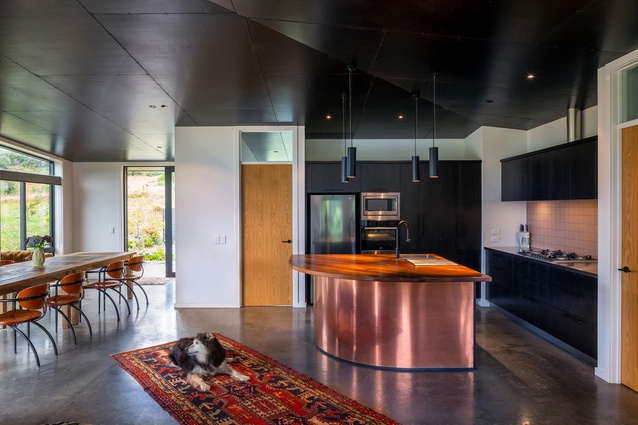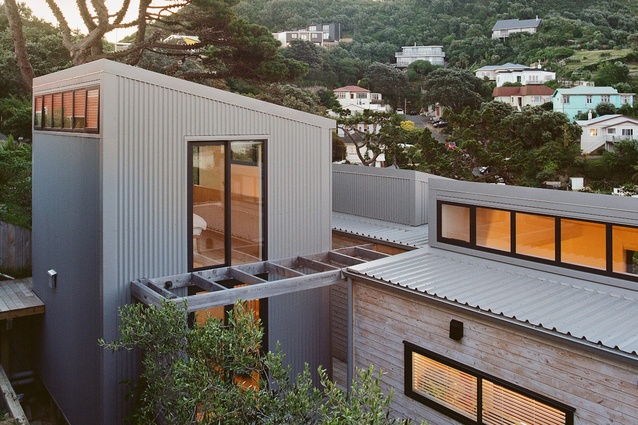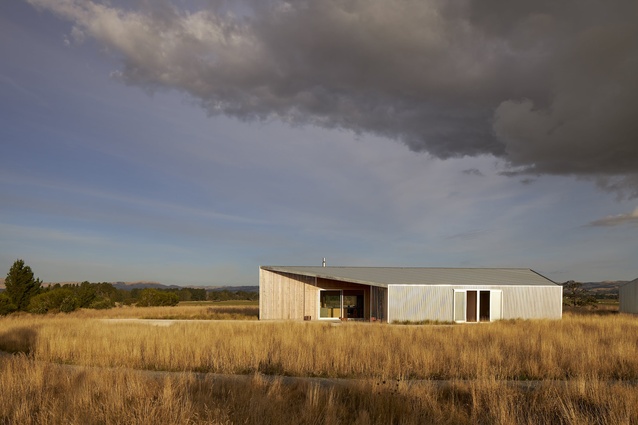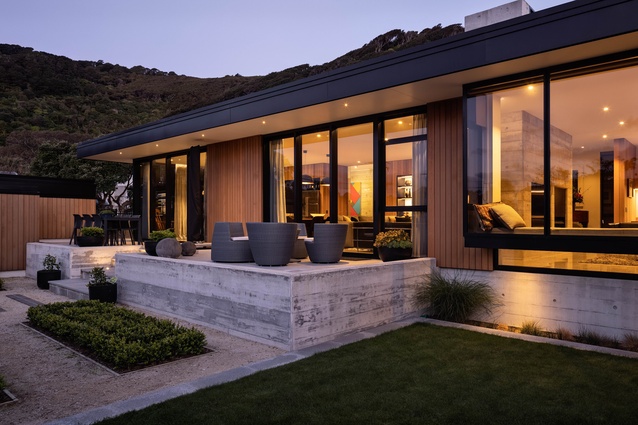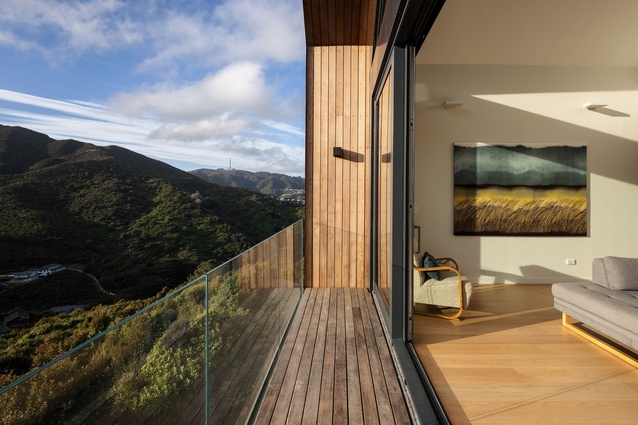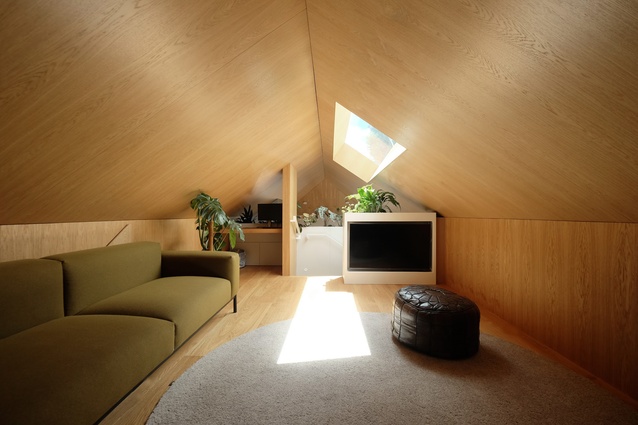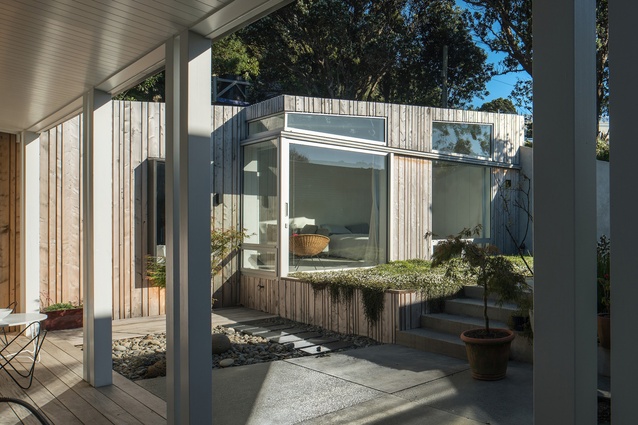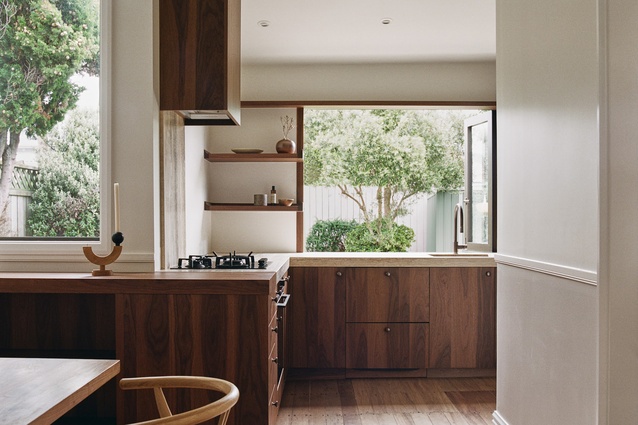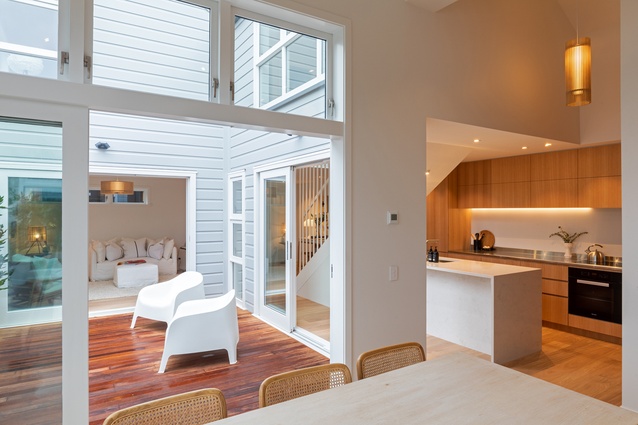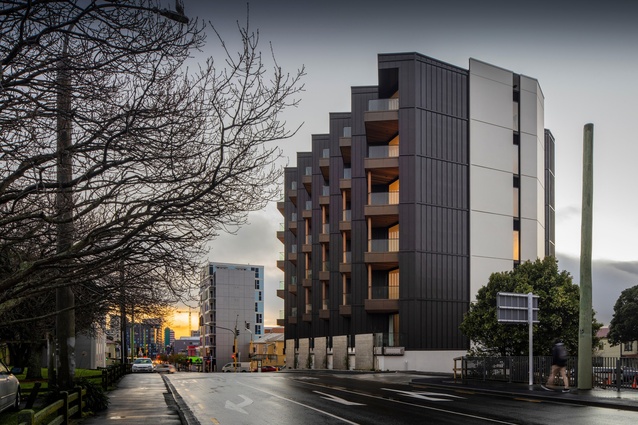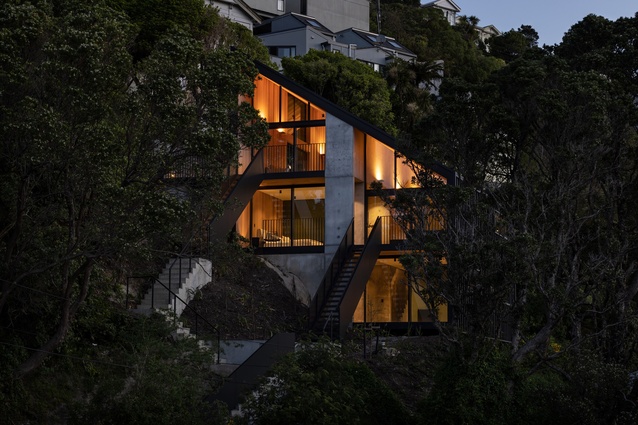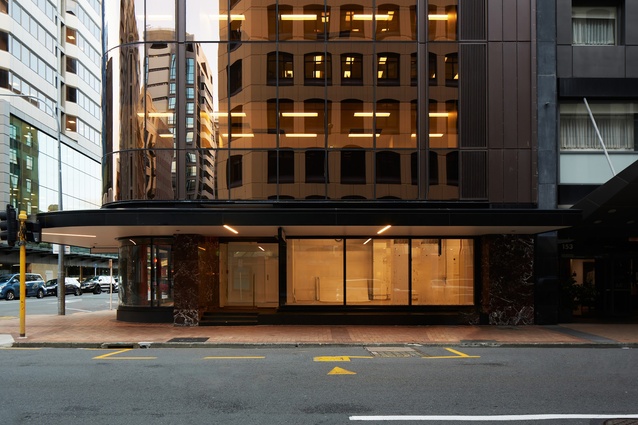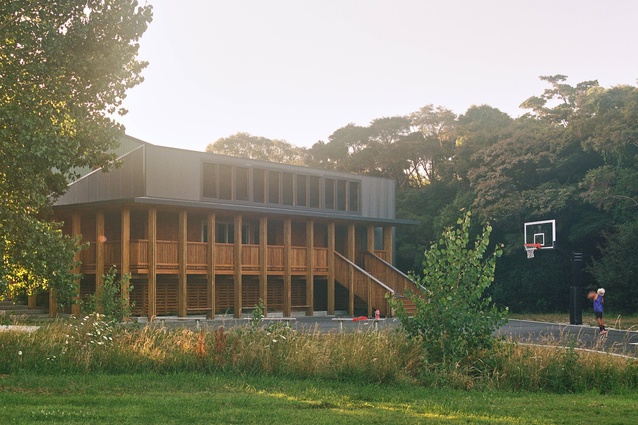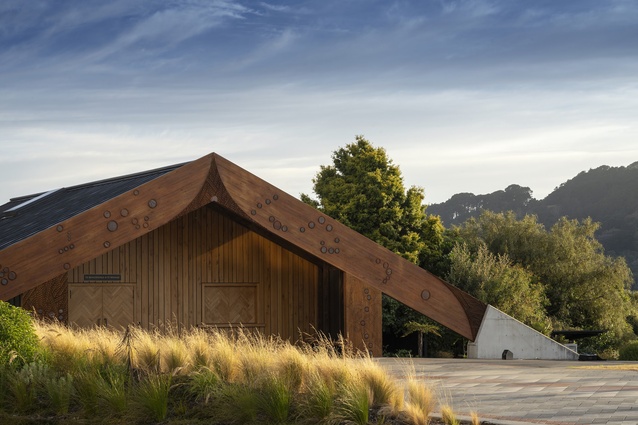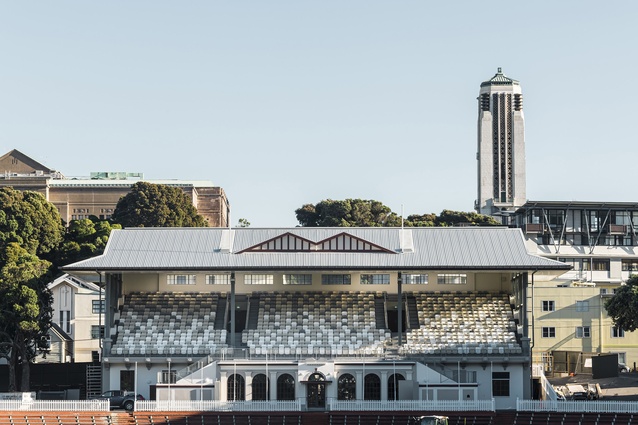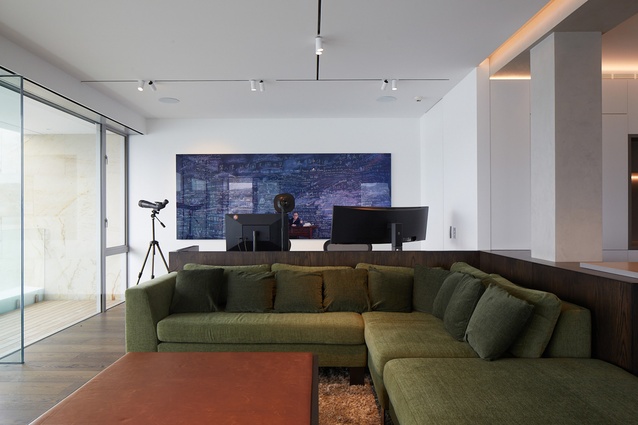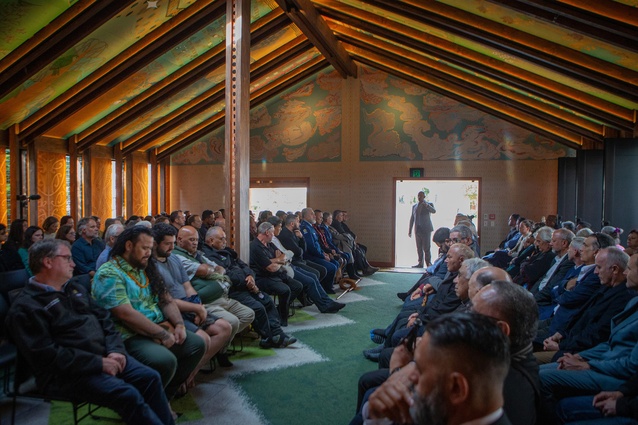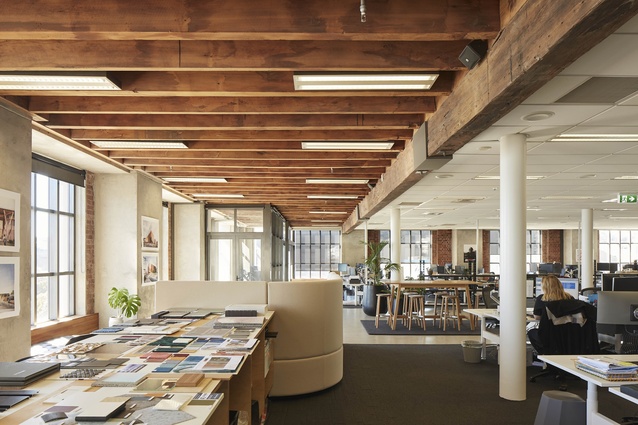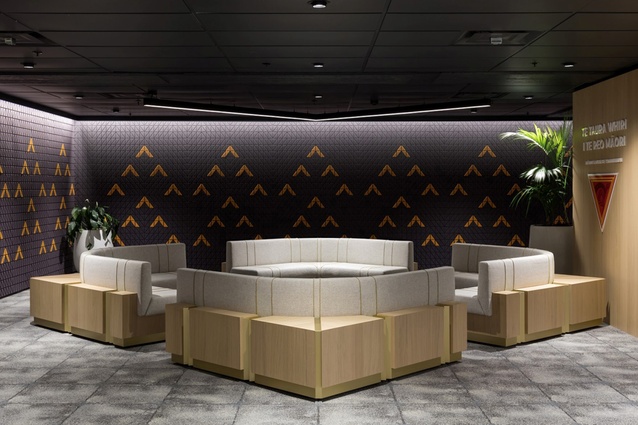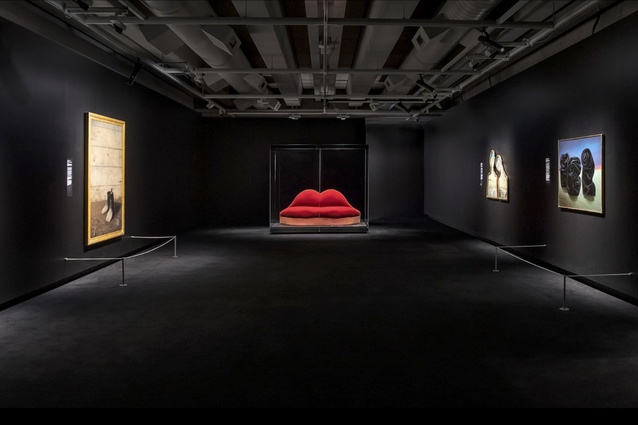Winners revealed: 2022 Wellington Architecture Awards
Twenty-three projects have taken out top prizes at Te Kāhui Whaihanga New Zealand Institute of Architects Local Architecture Awards ceremony celebrating the best architecture in Te Whanganui-a-Tara Wellington.
Successful projects included a glistening CBD office tower, a humble house that reflects the corrugated iron structures surrounding it, and a historic grandstand. Of the twenty-three winners, five projects also received a Resene Colour Award.
On the jury, convenor Belinda Tuohy of architecture+ was joined by Richard Dalman of Dalman Architects, James Warren of Upoko Architects, Emma Alcock of McKenzie Highman Architects and Maurice Clark of McKee Fehl Constructors (lay juror).
Tuohy said the judges were impressed by the variety and attention to detail the successful projects showed. “There was a sense of genuine pride mixed with humbleness in a lot of the projects. Architects in the housing category have been especially strong in exercising restraint in their projects while reaching high standards”.
The peer-reviewed awards jury described the projects as having reaffirmed that architecture in our capital region is flourishing.
Housing
Hinau Street House + Apartment by Parsonson Architects
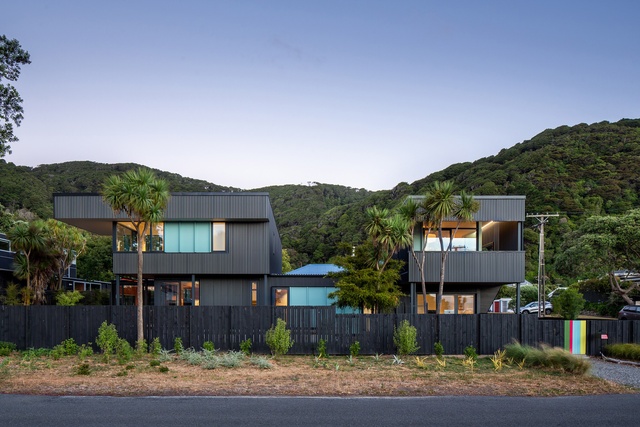
This home includes a main residence and an apartment which span across a corner section of land. The result is a successful addition to a long-established seaside suburb. The building has been reduced in size to a scale similar to the surrounding homes by sliding rooms outward from within to create a range of shapes rather than a single volume. This is evident in the collection of exterior walkways, overhangs, cantilevered roofs and internal courtyards. All promote the casual use of its many outdoor areas and an engagement with the surrounding street life which suits its seaside location.
Resene Colour Award winner
The Hinau Street House has been assembled from black corrugated iron, natural and coloured timbers and rich crafted interiors all of which reference and build upon the success of the practice’s past work. An unexpected use of brightly coloured panels peep through the kitchen joinery and boundary fence which all together create a sense of informality and a means to find a place for this home between a backdrop of dark green hills and the adjacent waterfront.
Buckley Road House by First Light Studio
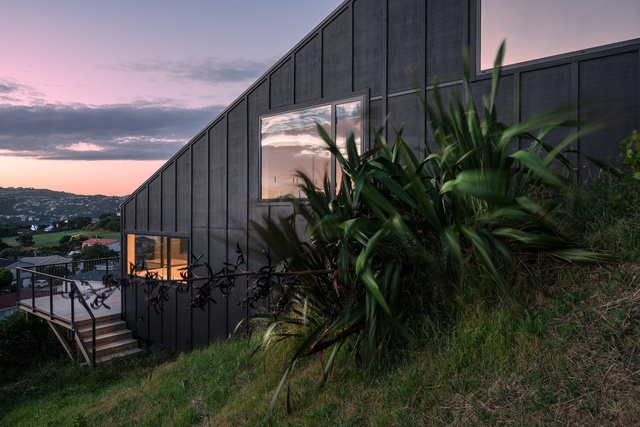
On first appearance this is a humble gabled home, but a closer encounter exposes a glowing timber entry porch that has been carved out of the dark exterior façade. Once inside, the simple planning concept of a long central stair is revealed. The stair acts as an internal ‘laneway’ as it steps down the site over its three levels. It provides access to both private and communal spaces along the way, enabling the family to be well-connected throughout the home. Strategically placed windows and skylights illuminate the house and provide coastal views stretching to the South Island, while still allowing for privacy from neighbours. This is a simple and clever home full of surprises.
Sparrow House by John Mills Architects
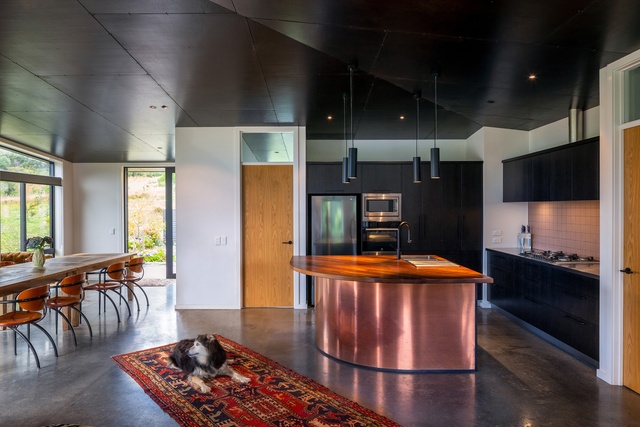
The Sparrow House has been thoughtfully positioned in a field behind a small rise in the land. A modest square floor plan has been mirrored around a centrally located kitchen in true Palladian style to create a full kaleidoscope of bay windows. Built-in seating and covered decks span outward from the centre to extend the full perimeter of the building. This creates panoramic views while providing many sunny spots to shelter from the prevailing winds. This is a deceptively simple house which responds superbly to its environment. It is constructed of materials appropriate to a rural home with workmanship to match.
Beach Forest House by Makers of Architecture
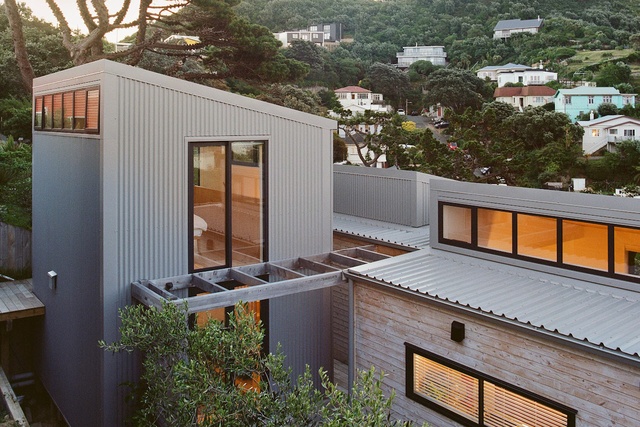
This project consists of a two-bedroom house and separate studio tower connected by external decks and courtyards. The forms are arranged in quadrants around a cruciform circulation, which is subtly reinforced in the orientation of the Cross Laminated Timber flooring and ceilings. A floating shelf above the kitchen bounces light from high level windows across the ceiling, giving the space a feeling of elevation whilst providing privacy from the residence up the hill. The detailing is meticulously executed, producing clean simple junctions that contribute to a sense of calm within the spaces.
Kahutara House by Patchwork Architecture
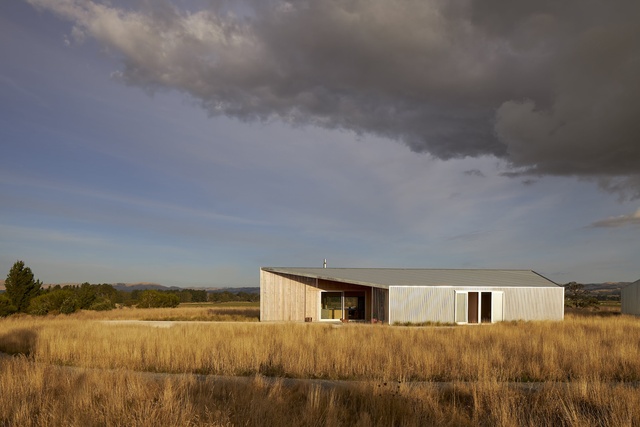
Kahutara House reflects the rural buildings in the Wairarapa field it sits in and enjoys views across nearby farmlands and foothills. Through its form, materials and crafty construction details, the house references the other corrugated iron structures in the area synonymous with rural Aotearoa. A thoughtfully composed floor plan divides the house in two, creating outdoor spaces on both sides of the house to enjoy shelter from wind, rain and sun while retaining a connection to the main living spaces. The house also captures a sense of ease and calm, elevating it well beyond a simple shed.
Matipo House by Studio Pacific Architecture
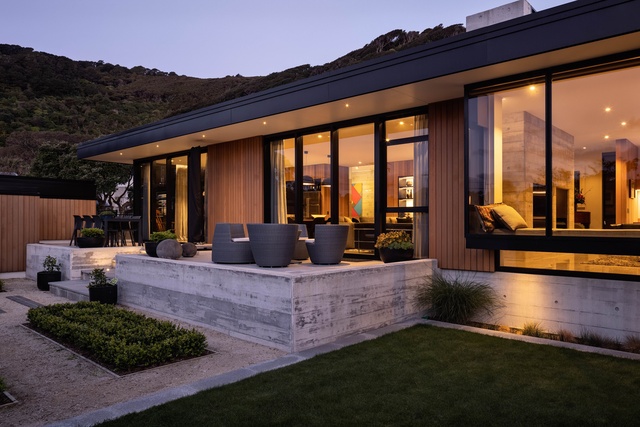
This is a well-ordered new home of substance that sits both confidently and comfortably on its seaside site. The street façade has been articulated to provide a similar scale to adjacent residences. Off-the-form, insitu concrete has been combined with the warmth of timber to provide a rich, textural sophistication both inside and out. The central concrete wall acts as a spine that separates the main entertaining living wing from the private bedroom and service areas and sits as its own element providing a base for artwork. This is a highly crafted home that has a strong sense of permanence.
Gable House by Three Line Studio
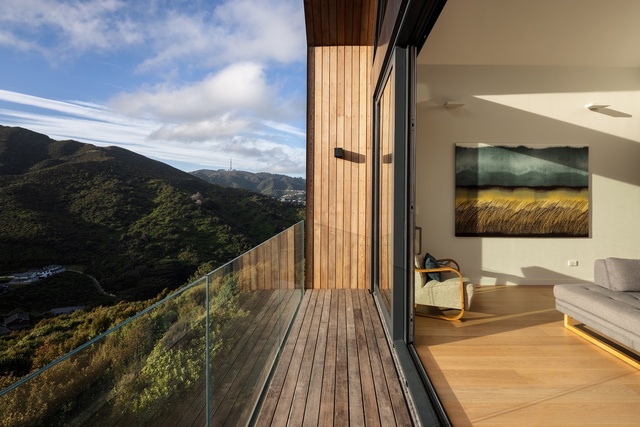
In contrast to surrounding homes, the Gable House has been built away from the street front, lowering the house from the road edge to create a degree of separation and privacy from its neighbours. The split-level home creates a series of single and double height spaces that link with outdoor courtyards down the hillside. The design of the home has been based on Passive House principles. It uses a number of construction methods to create an energy conscious home wrapped in a simple robust and low maintenance cladding. The house imbues a sense of solidity and permanence as it withstands nature’s extremes, all the while furnishing the needs of its family through life stages from parents with a baby to a house for teenage children and beyond.
Housing – Alterations and Additions
Carrington Cottage by a.k.a Architecture
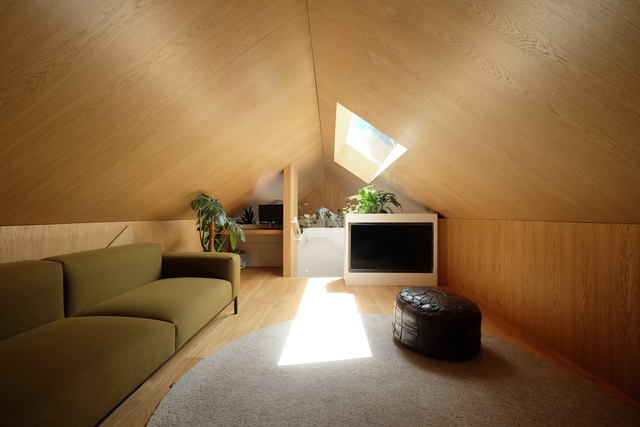
The unchanged external appearance of this circa 1900 workers cottage belies the transformation within. The narrow-gabled volume has been exploited to the full, creating a range of finely tuned spaces. A lofty volume over the living, kitchen and dining area goes through to a cave-like sleeping platform tucked under the roof. Linking the spaces is the gabled roof form refined to a skin of smooth ply panels, punctured only by a generous skylight which allows the timber to glow. The volumes are knitted together, Tetris-like with careful minimal detailing and a sparce palette of colours and materials to successfully amplify spaces.
Keith+Brown House by Judi Keith-Brown Architect
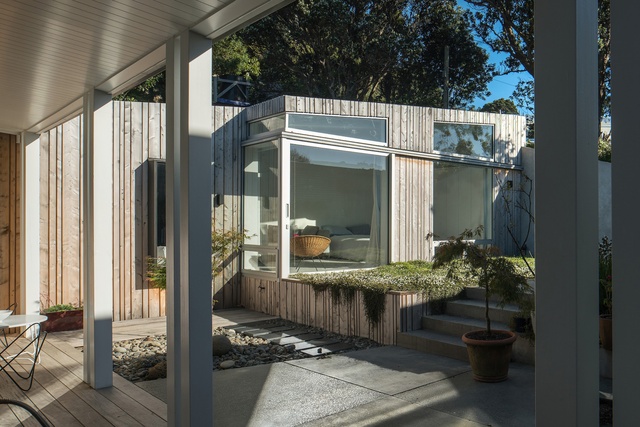
A well-considered intervention on this inner-city site where the house extends to enclose the sunny courtyard garden and redefine it as an outdoor room. The project is imbued with a thorough understanding of the significance of sustainable design. On the exterior this careful addition complements and respects the scale of the original 1887 villa, while introducing raw natural materials to contrast with the traditional painted finishes and link it to the exterior landscape. Inside the same diversity comes into play with a dark introverted gallery connecting to a light filled space with the succulent garden beyond.
MJ Residence by Seear-Budd Ross
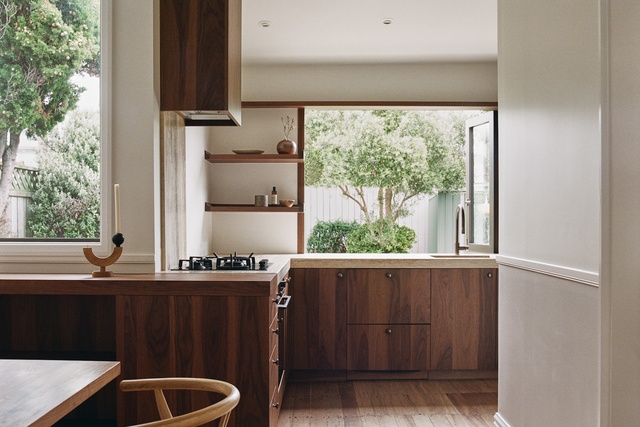
A small number of considerate and well-judged interventions have unlocked the potential of this home and its connection to a tight suburban site, transforming the original cottage into a house that is aligned with the needs of its current owners. The result is a thoroughly detailed and elegant series of interventions which both add to the story of this home and resonate with the original cottage. The cottage has retained its charm yet has an improved layout, more natural light and a warm and inviting atmosphere.
Housing – Multi Unit
Chappell Townhouses by Bonnifait + Giesen Architects
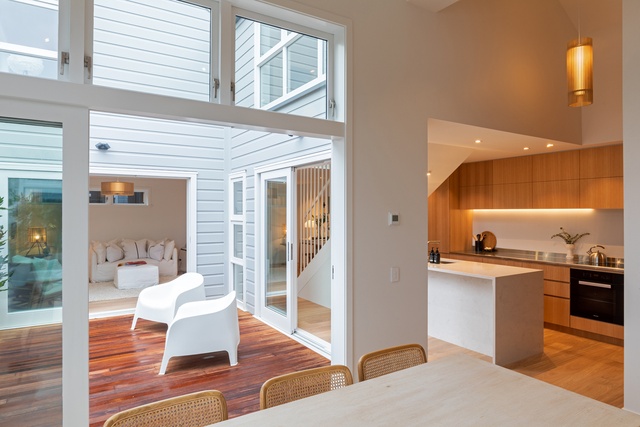
Despite the difficulties of working in a heritage area with complex planning rules, this project has managed to create both a new townhouse and reconstruct an existing working man’s cottage. It has produced two new dwellings. Both houses have been carefully set-out to fit a small section in a very dense urban environment. Clever planning has created a series of private indoor and outdoor spaces which receive ample sunlight and shelter from which to appreciate the views across Wellington City. This is no mean feat and testimony to the commitment of both client and architect to meet one of the challenges facing our generation and create quality infill housing.
Sunset West Apartments by Designgroup Stapleton Elliott
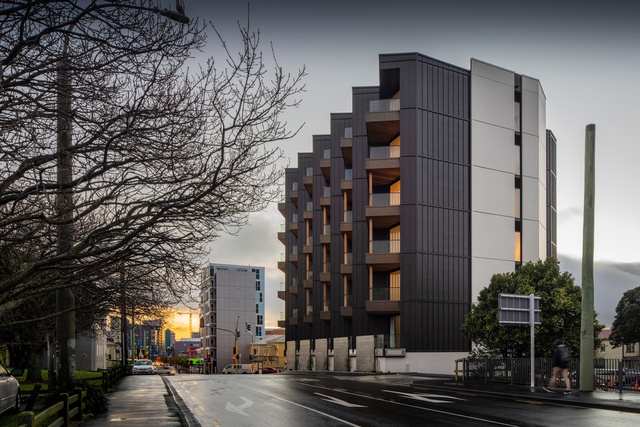
Sunset West provides boutique apartment accommodation through a focus on small, efficiently planned units with generous amenity. Attention to affordability enabled half of the development to be sold through the Kiwibuild scheme. The interior of each unit is furnished with plentiful storage, lining the whole length of the inter-tenancy wall. Additional joinery is used to separate the bedroom from the living room, with a simple sliding screen that allows the spaces to be either integrated or separated. The faceted façade angles windows and balconies towards the north, providing privacy from adjacent units and directing views across the city. From the street, the combination of the angled balconies with the vertical slatted screens gives the effect of tukutuku panel weaving.
Resene Colour Award winner
Materials and colour finishes have been carefully selected and crafted together to complement the exterior façades, and they significantly contribute to the architectural success of this landmark building. White painted and natural concrete and timber finishes combine with charcoal and bronze powder coated aluminium sheets to create the clever composition. The bronze sheets in particular glow when the sun strikes them late in the day. This building not only stands out because of its solitary position, but also because of its well-defined architecture that is enhanced by the material and colour palette.
Party Wall by Patchwork Architecture
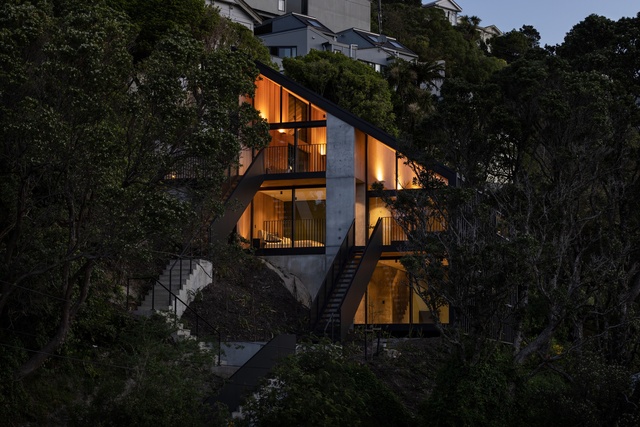
Divided by an impressive 1 metre wide in-situ concrete party wall that accommodates circulation and storage on both sides, the planning of these two units is like a well-played game of Tetris. The offset in floor levels between the two sides allows a simple form under a single sloping roof to create two upper floors with unique spatial qualities - one that feels enclosed and focused towards the concrete party wall, and the other that opens out to the sky and adjacent courtyard. Angled reveals to the kitchen windows allow the reflection of natural light into the space, and direct views out to the Kelburn bush. The detailing of the concrete wall and cedar interior is highly crafted and perfectly executed, creating a space of sculpture that feels rich and brooding.
Resene Colour Award winner
A material palette of raw concrete and natural cedar is complimented by a shade of deep green in the joinery and tiles, creating a moody interior that highlights the warmth of the cedar, and connects to the interior of the Kelburn bush outside. The interior is wrapped with dark Colorsteel cladding, allowing the raw concrete end of the party wall to dominate, and framing the warm glow of the cedar interior.
Commercial Architecture
Brandon House by Studio Pacific Architecture
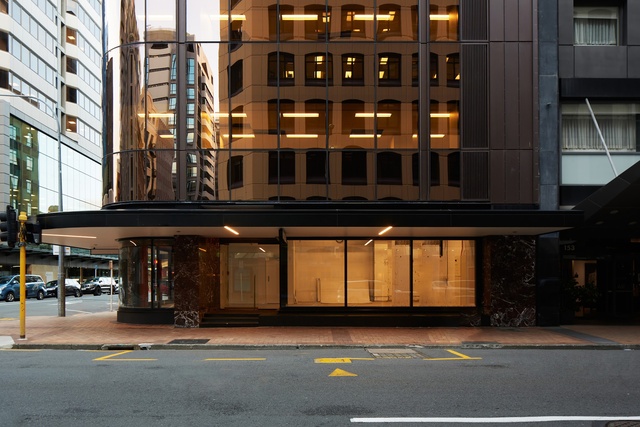
Originally destined for demolition and reconstruction, this 1960’s office building has been fully stripped back to its concrete structure and refurbished as boutique office accommodation. This holistic approach to refurbishment halved the embodied carbon compared to a new low-carbon build alternative. An additional three floors were added in timber construction, allowing for penthouse office accommodation on the top floor with views to Wellington Harbour. The new bronzed curtainwall sits respectfully adjacent Chartered Accountants House, while the curved street corner is a contemporary reflection of the faceted corners to buildings across the street.
Education
Whitby Collegiate Classroom Pavilion by Andrew Sexton Architecture
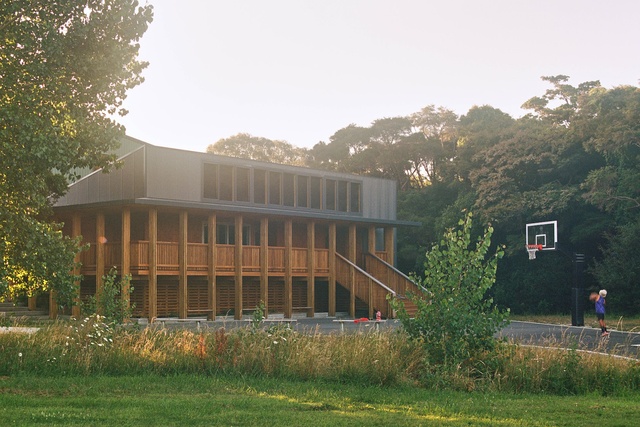
Utilising a marginal piece of shaded, sloping land, the architects have created a classroom with a warm timbered verandah that links the main campus with the field and paved area below. The building appears as a simple shed with double height glulam columns that anchor the building to the ground. The shed is a timber swathed pavilion against a backdrop of bush. Inside, the three modest spaces can open into each other providing a level of flexibility. Natural materials and quiet colours are used to reinforce a calm and tranquil environment.
Te Rau Karamu Marae by Athfield Architects and Te Kāhui Toi, Massey University in association
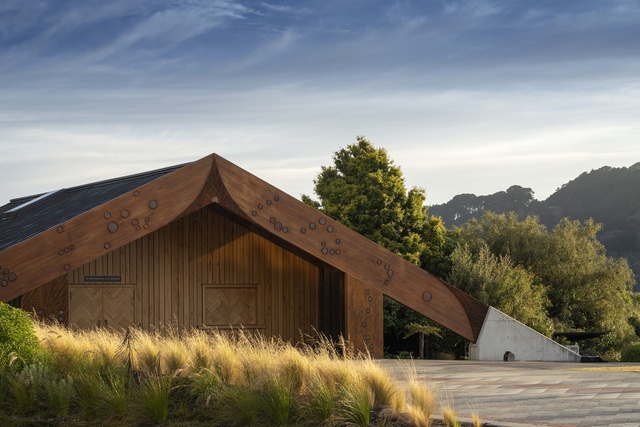
Te Rau Karamu Marae creates a new cultural heart to the centre of Massey University’s Wellington campus. The marae can host guests overnight and facilitate different types of teaching and learning, whilst also providing a place for retreat and rejuvenation. The marae acknowledges multiple connections and interfaces with surrounding campus buildings and the wider precinct. The atea opens out to the surrounding university courtyards and streets, holding its own mana without physical barriers through the use of patterned paving, planting and the carved waharoa.
Heritage
Cricket Museum Stand Restrengthening by Shand Shelton
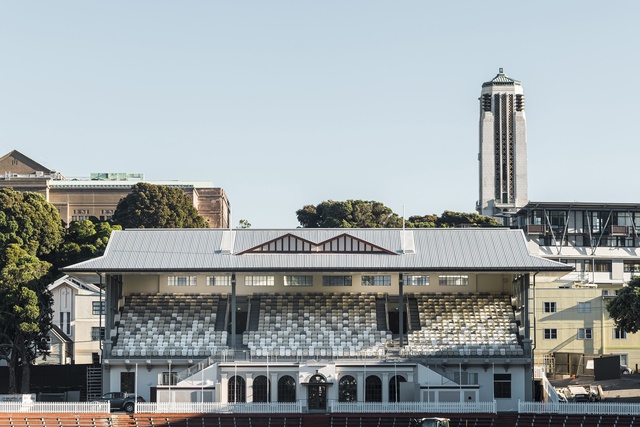
This Category 2 Heritage Listed building has been re-planned, strengthened and refurbished to suit its multiple uses including game day seating and amenities, Cricket Wellington offices and the New Zealand Cricket Museum. This has been achieved through not only enhancing the existing heritage character, but also exposing and reinstating original features previously hidden or removed. The new tiered seating has had its capacity increased and combines with new glass side walls and a predominantly white colour scheme to provide a contemporary, comfortable, and cheerful place to watch cricket.
Interior Architecture
Apartment C by Andrew Sexton Architecture
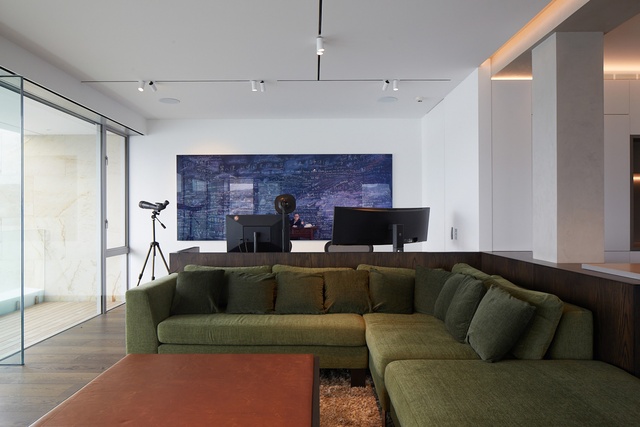
Entry to the apartment is on an upper level - directly into the stairway; a confined space, dark underfoot with tall white walls. Subtle lighting (natural and artificial) creates a sense of intrigue to invite one down to the living spaces. On both living floors the spaces are spare and uncluttered, elegantly detailed and opening out to the expansive view of the harbour and central city. The architects have used a limited palette of materials; glass, oak timber floors and doors, sisal carpets, mirrored walls and stone tiling, throughout the apartment to a provide a neutral space for the display of artwork and successfully create a tranquil living environment.
Te Rau Karamu Marae by Athfield Architects and Te Kāhui Toi, Massey University in association
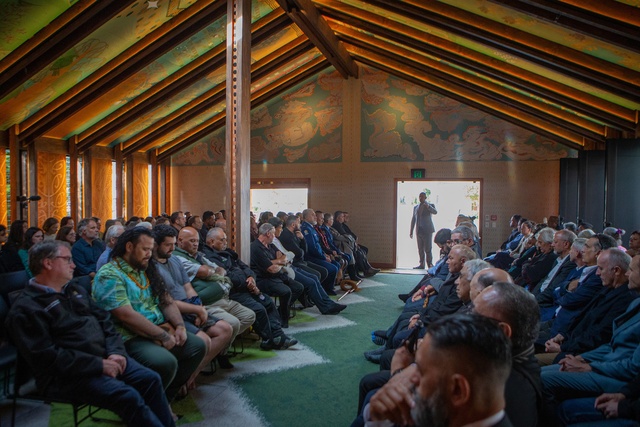
When entering Te Rau Karamu Marae there is an immediate sense of being immersed in nature, with the layering of posts, slot windows and skylights creating the effect of dappled light in a forest glade. The use of paired columns and rafters to conceal the necessary sprinkler pipes and lighting creates unfettered space for the contemporary kowhaiwhai panels, reaching up from the carved poupou panels to the ridge beam. Each panel represents a different tree species and depicts associated bird and insect life. The tukutuku panel on the entry wall has been meticulously hand woven with coloured ribbon into Autex panels. Above it, embroidered panels of the sky give a sense that the Cosmic Tree is reaching to the heavens. The space feels at once both grounded and uplifting.
Resene Colour Award winner
Pigment from Taranaki was specially roasted to create the rich colour of the carved totara pouou panels that anchor this interior space. The earthy tones transition to forest greens and heavenly blues, giving the space immediate connection to Te Rakau Tipua - The Cosmic Tree. Accents of orange and red in the hand-stitched tukutuku panel gives subtle liveliness to the interior.
Warren and Mahoney Wellington Studio by Warren and Mahoney Architects
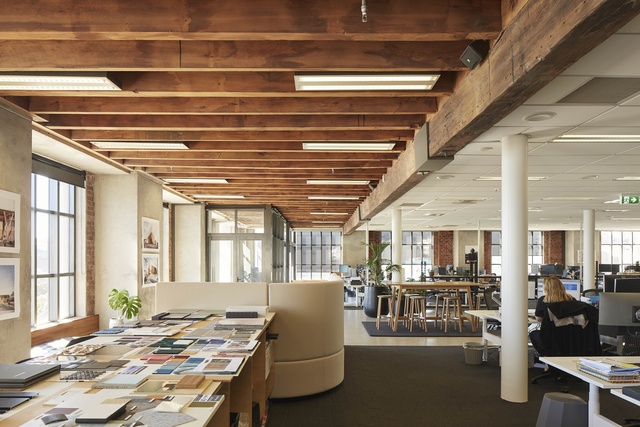
Warren and Mahoney’s new Wellington office gives dual-focus to the roles of being both a host and promoting staff well-being. On arrival visitors are greeted at a polished brass reception counter, which doubles as a servery for functions by the simple removal of the cardboard tube countertop upstand. A promenade of polished concrete floor connects visitors and staff into the heart of the open-plan studio, a place to gather, exchange ideas, and share in celebrations. The interior exploits the rich materials of the old Odlins Building - exposed brick, natural timber rafters and concrete floors - to provide a textured backdrop for new contemporary interventions. This project is a skillful exercise in restraint, recognising not just how much to add, but also what to remove and reveal.
Small Project Architecture
Te Taura Whiri i te Reo Māori – The Māori Language Commission by RCG
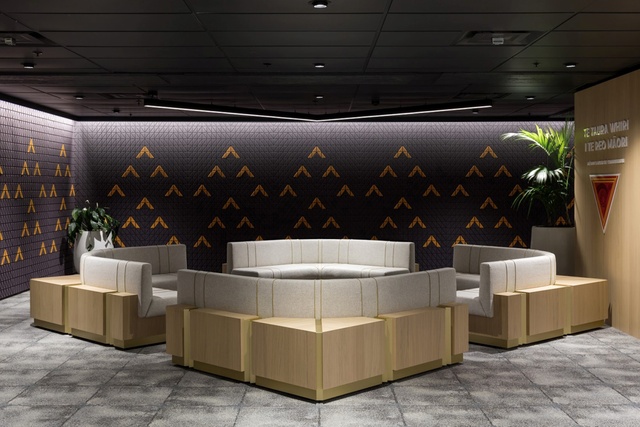
This is a thoughtfully designed, multi-use space where Te Reo revitalisation and ideas can be fully exchanged; a space designed to echo the language – one that can feel at times intimate and engaging and at others, open and vibrant. Beautifully designed and crafted elements include carved door handles that act as a gateway into the space. The bespoke Autex wall tiles can be arranged in any of the Niho Taniwha expressions. Existing furniture has been combined with new bespoke joinery to create a kit of parts that can be arranged to a particular use, from small to large hui, workshops and kōrero. While creativity and flexibility are key, there is a strong sense that everything has been undertaken with a clear rationale.
Te Papa Surrealist Art: He Toi Pohewa by Warren and Mahoney Architects
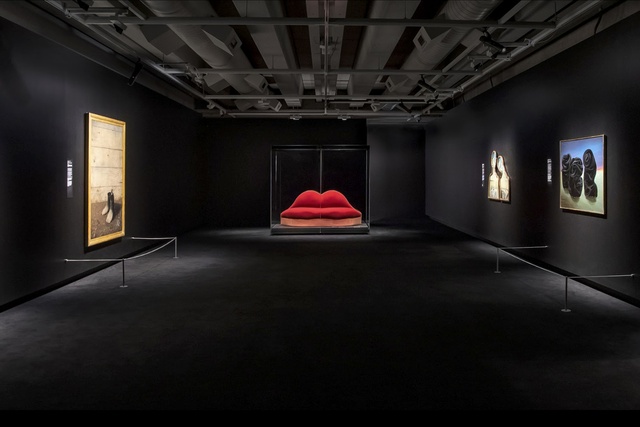
The design successfully explores how space can be an agent to entice visitors closer to the artists and their practice. The exhibition is divided into six thematic sections that correspond to six major ideas of Surrealist practice and spatially identified through colour, lighting, texture, pace, and assembly. Entering the exhibition, the visitor immediately encounters an unfamiliar reality; the black surrounds, soft, thick carpet underfoot, Satie classical music, and art objects illuminated like a series of jewels. Proceeding further brings a journey through a series of spaces that are surprising, delightful, confounding and unsettling, an altogether surreal experience.
Resene Colour Award winner
Within the allocated gallery spaces colour is adroitly used to define space and conjure different moods. The exhibition design includes a multiplicity of very different colours; soft enveloping black, sharp edged white with red imprints, deep dark recessive blue, warm burnt orange, warm greys and light toned timber, dirty pink, and a light ethereal blue. They are employed to support the six thematic sections that underpin this exhibition design and structure the viewers journey through their experience of Surrealism.
Planning and Urban Design
Ōmarukaikuru by Isthmus Group

Ōmarukaikuru / Point Jerningham is a prominent section of walking and cycling infrastructure of Tahitai, (one tide, one journey) the coastal route from Oriental Bay around Evans Bay. Ōmarukaikuru comprises pathways for cyclists and pedestrians, a series of projecting outlooks, ‘barnacles’, resting spaces and access points to the rocky foreshore. The design references and responds to the context on many levels; cultural naming of whenua with Taranaki Whānui, tohu design, marine ecosystem, coastal resilience and natural rock formations of this rugged coast. A simple and rustic material palette of exposed aggregate and asphalt give clear cues for different path users, facetted precast concrete and corten steel for feature structures softened by hardwood timber inlays and hardy coastal planting celebrates this rugged exposed environment.
The NZIA Local Architecture Awards 2022 programme is supported by Resene and APL.

